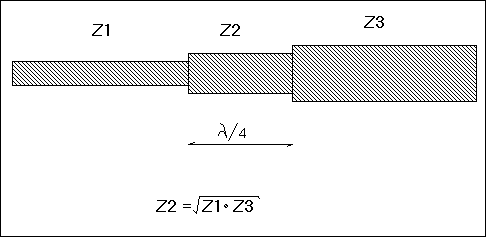Special cases of the quarter wavelength
conversion
Above seen method is used to convert different
impedances together without affecting standing wave reflections.
The resolution of convert impedances Z1 and Z3 is a piece of line which
impedance is Z2. The length of the line must be equal a quarter wavelength.
Special cases of the impedance conversion method
Metallic insulator
This paradoxal case is when there is a quarter wavelength wire which is grounded
on the other end, so short circuited. The case is present for example when
transmission line is mounted on ground by quarter wavelength metal rods.
Does it not mean short cicuit? Contrary no, it means insulation. Lets solve
the equation Z1 = Z22 / Z3. When Z3 is shorted its impedance
is zero and Z1 becomes infinite, so-called insulator. This not only a theory
but very practical use.
How an insulator becomes to short circuit
Contrary but also a paradoxal case is when a quarter wavelength wire
is left open on the other end.
Then the impedance of Z3 is infinite or insulator. Lets solve the equation
Z1 = Z22 / Z3 and we'll found that Z1 becomes zero or it
means short circuit.
We can note that it is not a good practice to leave some lateral brances
to a transmission line. It is same as leave short circuits here and there.
The open dipole antenna is an application of this. The branches of it are
usually quarter wave length. And one point of a good antenna is that it is
eating all the singnal from antenna cable and not reflecting any part of
it back.
11.10.2003
Martti Palomäki

